***
I was born in Taoyuan County on the banks of the Yuan River in Hunan. and I grew up in Changde, Xiangxi. I’ve yearned to go back and visit for many years. I also wanted to visit Fenghuang and Chatong in search of my youthful memories and see the sights and sounds that Shen Congwen wrote about. In the fall of 1988, I finally traveled with three young painters from Hong Kong to Xiangxi for a plein-air painting trip.
我出生在湖南沅水邊的桃源縣,少年時代是在湘西常德城長大的,這多年來,總想回去看看,順便去去鳳凰與茶峒追尋那少小時的印象、和沈從文筆下的湘西風情。於是在一九八八年秋天與三位香港青年畫家結伴赴湘西旅行寫生。
Jishou is the capital of Xiangxi and was once known as Suoli. Today, it is the political, economic and cultural center of Tujia and Miao Autonomous Prefecture. There are large and small factories everywhere in the city and there is a layer of dust over everything. The dusty roads, the piles of sweet potatoes on the roadside, the honking of car horns as well as young girls with shoulder-length hair dressed in the latest fashions create an interesting urban composition. The only hint that you are in Xiangxi is the occasional woman in traditional Miao headdress and clothing. It is a Xiangxi that has felt the touch of reforms and liberalization.
湘西首府吉首過去稱所裡,現在是土家族苗族自治州政經文化中心,大大小小的工廠滿蓋灰塵地佈滿了城市四周。馬路上的塵土、街邊大堆小堆的涼薯,汽車的高音喇叭與長髮披肩,穿著時髦的姑娘構成城市的有趣畫面。只有一些穿插其中的苗人婦女的大包頭和衣著告訴人們這就是湘西,改革開放已然啟動的湘西。
Light rain greeted us when we reached in Aizhai. We took an old and dilapidated bus that slowly crawled its way up to the precarious Aizhai Highway and stopped at a small privately-owned roadside diner to enjoy Xiangxi’s famous tender tofu before continuing on to Chatong Town.
車到矮寨,細雨中,我們乘坐的破舊公車緩緩爬過地勢奇險的矮寨坡公路,在公路邊個體戶的小飯館吃聞名湘西的嫩滑豆腐,之後,向茶峒鎮馳去。
Chatong owes its fame to The Border Town, a novel written by Shen Congwen that is considered his representative work. The three provinces of Hunan, Sichuan and Guizhou come together at Chatong. A mix of Han, Miao and Tujia make up the town’s population of nearly twenty thousand and it was once known as “Little Nanjing.” Most of the older generation still remember the old boatman that Shen Congwen wrote of. They also know that Cuicui was Ms. Yu and that she wore hair long instead of in a braid. After the oldest and second oldest sons died in Changde when their boat capsized, Ms. Yu’s stilt house was also washed away in a flood. She is said to have to married someone in Chengdu and has not been back ever since. We came across Jiang Bo, the old boatman, right away when we arrived at the Hong’an ferry landing in Chatong. He was in good health and had white hair – the spitting image of Cuicui’s grandfather and old boatman in Border Town. During our chat with him, we learned that he and Old Yu were both Chatong ferrymen. Yu lived about a mile downstream while he has always stayed at Hong’an. More than fifty years have gone by but he still remembered everything quite clearly.
茶峒,因沈從文的代表作,小說《邊城》而聞名。它位於湖南、四川、貴州三省交界,鎮上有人口近二萬人,苗漢、土家族雜居,舊時有「小南京」之稱。現在老一輩的人,都還知道沈從文筆下的那位老船工,而翠翠就是余小姐,而且,是披披頭不是大辮子。大佬、二佬翻船死於常德後,余小姐家的吊腳樓也被洪水沖走了。聽說後來嫁去成都,而且一直沒有回來過。
老船工蔣伯,是我們一到茶峒──洪安渡口就發現了的。他身體健康,白髮蒼蒼,很像《邊城》中的老船工──翠翠的爺爺。和他聊天,知他與餘老頭同為茶峒渡工,餘在下游一裡多處,他一直在洪安渡口,已五十多年了,過去的一切還約莫記得。
Finding Cuicui. When we arrived in Chatong our group decided to find someone to model “Cuicui” for us but our search was unsuccessful. Eventually, third brother find a girl named Liu and asked her if she looked like Cuicui. Liu had long hair and wore a red top. She also wore long pants and high heels that gave her a modern, youthful look. She wasn’t shy or reserved like Cuicui in the novel either but she was a local Chatong girl. I could only sigh after the painting session – Cuicui was unique after all.
找翠翠。到茶峒後我們幾人就相約注意找一個「翠翠」來畫,但始終不見。最後還是三哥找來一位小劉姑娘,問是否像翠翠?劉姑娘紅衣披髮,長褲,高跟鞋,小有摩登青年的味兒,也不像小說中的翠翠那般含蓄和羞怯,但終究還是茶峒姑娘。畫完之後,只能輕輕嘆息,畢竟翠翠是無人能夠替代的。
Fenghuang was an important stop in our plein-air painting trip. It is Sheng Congwen’s home town and also home to the famous Tujia painter Huang Youngyu. Huang is a great fan of the town probably because it still retains many of its rustic stilt houses and old gatehouse. What I discovered was that the town has become a popular painting destination for art students and teachers in China in recent years. That was why a kind old lady came up to me while I was painting the city gate and said: “Two or three days go by at most between people painting this gate house.” She turned out to be an aunt of Huang Yongwu. People have gotten used to all the young artists and teachers coming here plein-air painting in the last few years. It gives them a sense of pride and enthusiasm for Fenghuang.
鳳凰是我們這次寫生造訪的重點,是沈從文的故鄉,也是土家族名畫家黃永玉的家鄉。由於她仍保留不少古樸的吊腳樓、舊城樓的緣故吧,得黃永玉的大力宣傳,近年來,成為大陸美術院校師生和畫家寫生的「熱點」,這是我過去所不知道的。所以當我畫那城樓時,一位祥和的老太太就告訴我:“這樓呀,三天兩頭就有人畫。” 她原來是黃永玉的嬸娘呢。這幾年來,各地來此寫生的美術青年、老師日多,人們也見慣不怪了,且對他們露出既熱情又略帶自豪的神態:我們的鳳凰也有令人驕傲的東西!
Fenghuang was named Tuojiang Township because the Tuo River winds its way around the town. We made a pilgrimage to the former residence of Shen Congwen at No. 24, Zhongying S. in Tuojiang Township. The wooden front doors have just been re-installed and have not yet been varnished. There are two side rooms right inside the front door, followed by an open-air courtyard with more side rooms. Beyond that lay the main hall with two more large side rooms. A flight of wooden stairs beyond the central hall led to the second floor, while the kitchen and storeroom lay at the back of the house. The carved wooden grating in the main hall looked a little old and worn. Shen’s sister-in-law is named Luo Lan and she is the custodian of the house. Though she was in her seventies, she was quite spry for her age and had a refined, educated demeanor. She said the house was being restored and should be re-opened to the public in April or May next year.
鳳凰縣有陀江繞城而過,故名陀江鎮。我們一行四人懷著崇敬的心情,探訪坐落在陀江鎮中營街24號的沈從文故居。重新裝上的大木門,尚未髹漆,一進大門是兩個廂房,天井中有側房,然後是正廳,又兩大廂房,中堂後有木梯上樓,再後是廚房倉屋,正廳的木格雕花門顯得殘舊。沈老的弟媳婦看守故居,她叫羅蘭,雖是七十多歲的老人,仍精神清朗,談吐溫文,想亦是知書達禮人家。這故居正在修復,她說,大概明年四、五月可以完工開放吧。
The people in this town have lived a more natural and relaxed life over the past few decades. The climbing costs of living as well as pop songs and jeans from Taiwan and Hong Kong seem to have caught them a little off-guard. They stubbornly insist on speaking to everyone in a thick Xiangxi accent and cover every dish with crimson chili. All of the older people in the town miss the fifties with its stable prices. They had a favorable view of the Communist Party ‘s bandit hunting efforts. Unfortunately, more than forty historic buildings in the city were destroyed or fell into disrepair. The past was therefore falling apart and nobody could be certain of what will happen in the future. The regular announcements for policy education over the town’s public address system seemed to be the only reminder that the “old days” are now gone.
經過幾十年來,這小城的人們現在過著一種較為自然而寬鬆的日子了,而面對改革開放後這狂升的物價、港臺的流行曲和牛仔褲,他們又有些茫然。他們總是頑固地對任何人都操著極重的湘西口音說話,又用紅殷殷的辣椒覆蓋所有的菜餚。城中上年紀的人多懷念五十年代物價平穩的生活,對共產黨湘西剿匪尤為稱道。說起城中原有四十幾處古蹟的被毀與殘破失修則無可奈何,十分惋惜。過去的已殘缺不全,對未來誰也說不清楚,彷彿只有每天城中定時的有關政策教育的有線廣播在提醒人們這不是「舊」社會。
Nobody here knew much about “corpse driving” (a local custom of delivering the corpse back to the dead’s hometown) or “cave spirits” (local legend about young women whose souls being stolen by cave spirits). Only the tradition of antiphonal singing between young Miao men and women continued to thrive. I still remember how Miao couples sang to each other in the fields by the light of dusk after the end of the Jiangshan market. A former soldier in the village told me that by Miao custom, the men and women would greet and chat with each other first. They only move on to antiphonal singing if they see eye to eye. The circumstances of both parties are communicated through singing, and marriage may then happen after that. When we went to the Miao homeland at Laershan later on, we heard three couples singing to each other. I rushed out with a torch but there was nobody to be seen. There was only a faint song in the air that faded into the night.
(Originally published on November 19, 1988, on page 8 of China Evening Times)
問起「趕屍」和「落洞」都沒有人說得出所以然來,唯有苗族青年男女的對歌戀愛的風俗則一直流傳至今。記得在苗鄉山江集市散後,暮色中,果然看見苗人出雙入對地在郊野相對唱歌。村子裡有一轉業軍人告訴我,苗族對歌習慣是男女先搭腔,再聊天,談得來才對歌的。雙方情況都是以歌來問答,這以後才到嫁娶,男方送禮主要是那套苗女盛裝所佩戴的銀器,約值二三千元吧。後來我們去臘爾山苗鄉時,傍晚又聽見三幾苗女對歌。當我拿著手電筒趕出去時卻不見人影,只有歌聲細細飄去,沒入迷濛的夜色之中。
(原文刊登於1988年11月19日《中時晚報》第8版)

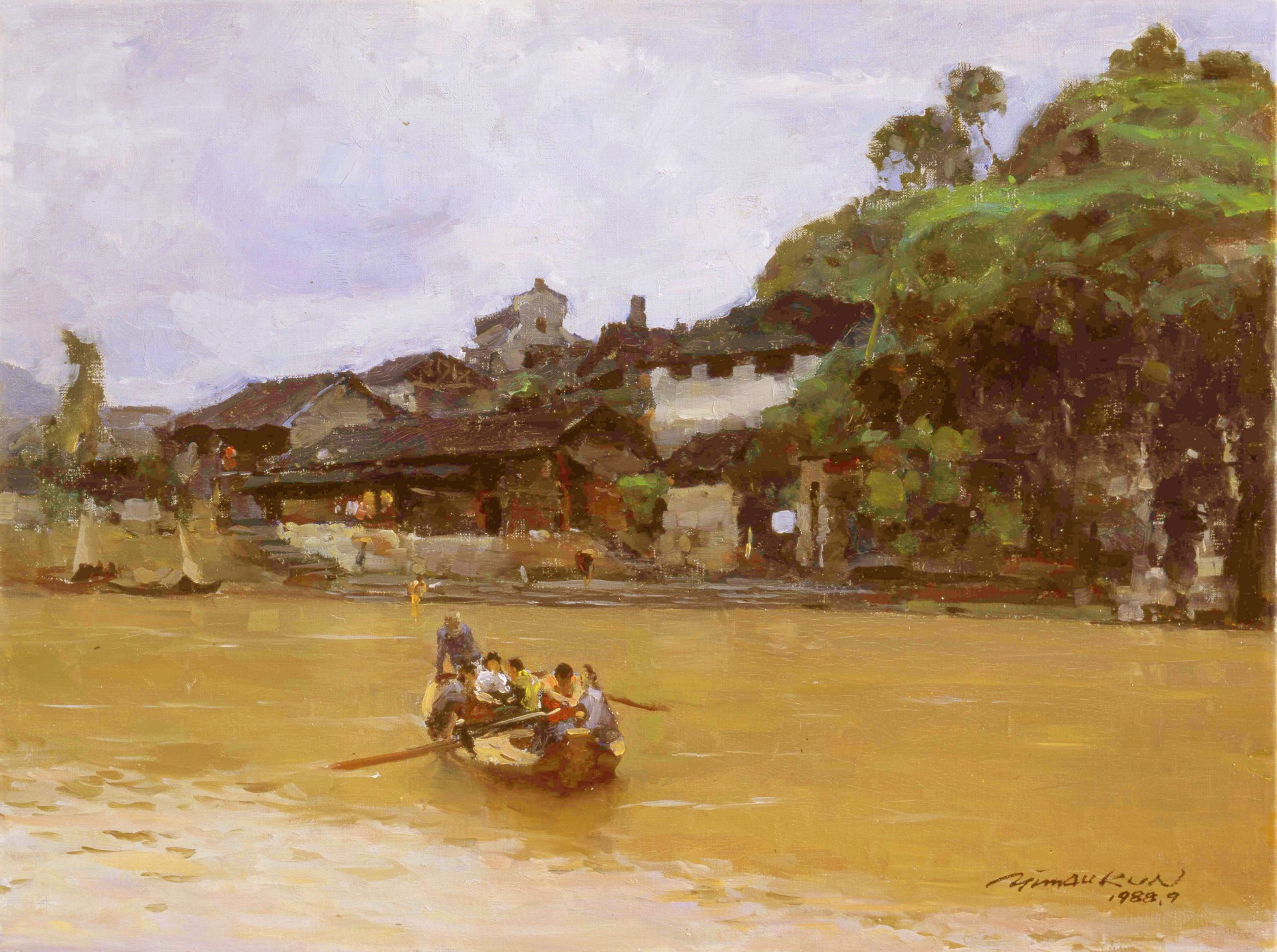
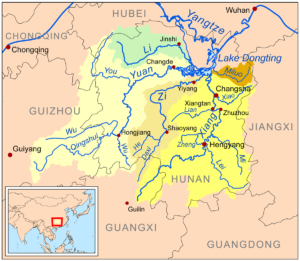
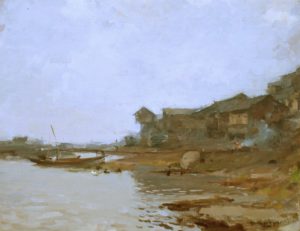
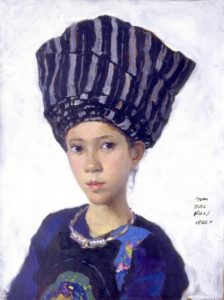
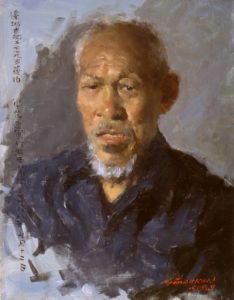
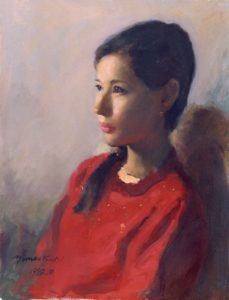
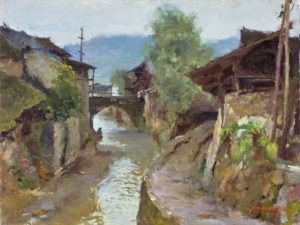
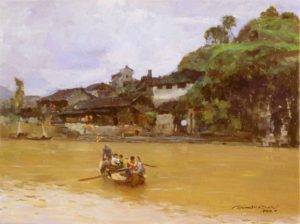
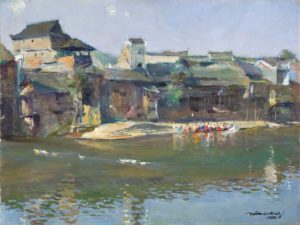
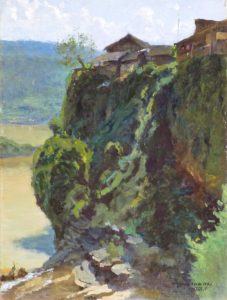
16x21-inches-1988-300x232.jpg)

A very interesting story and wonderful paintings。 In China there seems to be many good places for plein air paintings。